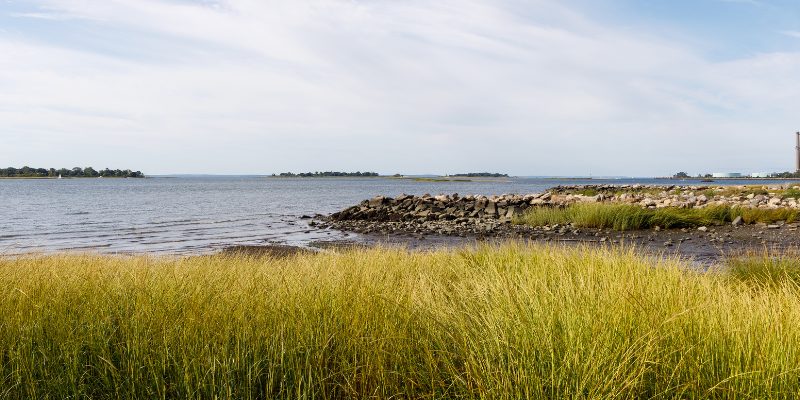Connect Now: 516-273-6428
What Are The Effects Of Salt-Air On Roofs?

Living on Long Island offers beautiful coastal views, access to stunning beaches, and a unique lifestyle. However, the proximity to the ocean also means your home, particularly your roof, is exposed to salt air. From Montauk and Sag Harbor to Oyster Bay, the salty environment can have significant impacts on the longevity and maintenance of your roof.
Let’s explore how salt air affects different roofing materials, the signs of salt damage, and how you can protect your roof from the harsh coastal environment.
How Salt Air Affects Different Roofing Materials
Salt air is a mix of moisture and salt particles that can accelerate wear and tear on your roof. The impact varies depending on the material used for your roof.
Metal Roofs
Metal roofs are popular for their durability and modern appearance, but they are particularly vulnerable to salt air:
Corrosion and Rust
Salt is highly corrosive to metals. Over time, salt particles can cause metal roofs to rust and corrode, weakening their structural integrity.
Paint and Coating Degradation
Salt can erode protective coatings and paint on metal roofs, leading to exposure of the underlying metal and accelerating corrosion.
Asphalt Shingles
Asphalt shingles are a common choice for residential roofs, but they can also suffer from salt air exposure:
Granule Loss
The abrasive nature of salt particles can cause the protective granules on asphalt shingles to wear away, reducing their effectiveness and lifespan.
Cracking and Brittleness
Constant exposure to salt and moisture can cause asphalt shingles to become brittle and crack, making them more prone to damage from wind and impacts.
Tile Roofs
Tile roofs, often made of clay or concrete, are more resistant to salt air but are not immune to its effects:
Surface Erosion
Salt can erode the surface of tiles over time, leading to a rough, weathered appearance.
Moss and Algae Growth
The moist environment created by salt air can promote the growth of moss and algae on tile roofs, potentially leading to further damage if not addressed.
Wood Shakes and Shingles
Wood roofing materials can be significantly affected by salt air:
Warping and Splitting
Wood can absorb moisture from the salt air, causing it to warp, split, or swell.
Decay and Rot
The combination of moisture and salt can accelerate the decay and rot of wooden shingles, reducing their lifespan and effectiveness.
Flat Roofs and Membranes
Flat roofs, often covered with rubber or synthetic membranes, have their own challenges with salt air:
Sealant Degradation
Salt can degrade the sealants and adhesives used in flat roof systems, leading to leaks and water damage.
Surface Wear
The constant exposure to salt can wear down the surface of synthetic membranes, making them more susceptible to punctures and tears.
Signs of Salt-Air Damage
Recognizing the signs of salt-air damage early can help you take action before significant problems develop:
Rust and Corrosion
Look for rust on metal components such as flashing, gutters, and metal roofing panels. Corrosion may appear as red or brown stains and can weaken the metal.
Granule Loss on Shingles
Check for excessive granules in your gutters or at the base of downspouts, which can indicate that your asphalt shingles are losing their protective layer.
Cracks and Brittle Shingles
Inspect shingles for signs of cracking, curling, or brittleness, which may be exacerbated by salt exposure.
Algae and Moss Growth
Look for green or black streaks on your roof tiles or shingles, which can indicate algae or moss growth due to the moist, salty environment.
Warped or Decayed Wood
Check wooden shingles or shakes for signs of warping, splitting, or decay, which are common problems in salty, humid conditions.
Degraded Membranes
Inspect flat roofs and membrane systems for signs of wear, tears, or sealant failure, especially around seams and edges.
Protecting Your Roof from Salt-Air Damage
Choose Resistant Materials
When selecting roofing materials, consider those that are more resistant to salt air:
Galvanized or Stainless Steel
For metal roofs, use galvanized or stainless steel, which offer better resistance to corrosion.
Salt-Resistant Coatings
Apply protective coatings designed to withstand salty environments on metal and concrete tiles.
Synthetic Roofing Materials
Consider synthetic shingles or membranes that are less prone to salt damage.
Regular Maintenance and Cleaning
Regular maintenance can help extend the life of your roof in a salt-rich environment:
Wash Your Roof
Rinse your roof with fresh water periodically to remove salt deposits, especially after storms.
Clean Gutters and Downspouts
Ensure gutters and downspouts are free of salt-laden debris to prevent water damage and rust.
Inspect for Damage
Regularly inspect your roof for signs of salt damage, including rust, granule loss, and moss growth.
Protective Coatings
Applying protective coatings can shield your roof from the corrosive effects of salt air:
Sealants for Shingles and Tiles
Use sealants to create a barrier against moisture and salt on shingles and tiles.
Rust Inhibitors for Metal
Apply rust-inhibiting primers and paints to metal roofs to prevent corrosion.
Proper Ventilation
Good ventilation helps to reduce the impact of salt air on your roof:
Attic Ventilation
Ensure your attic is well-ventilated to minimize humidity and moisture buildup.
Roof Vents
Install roof vents to allow salt-laden air to escape and fresh air to circulate.
Trim Overhanging Trees
Trees can drop salt-laden leaves and debris onto your roof, exacerbating the effects of salt air:
Regular Trimming
Keep trees trimmed back from your roof to reduce the amount of debris and shade that can promote moss growth.
Maintain Clearance
Ensure there is sufficient clearance between tree branches and your roof to prevent physical damage and moisture retention.
Schedule Professional Inspections
Regular professional inspections can help identify and address salt-air damage before it becomes a major issue:
Bi-Annual Inspections
Have your roof inspected by a professional at least twice a year to check for signs of salt damage and overall wear and tear.
Post-Storm Checks
Schedule inspections after significant weather events to ensure your roof has not suffered salt or wind damage.
Address:
11 Katie Ct, Lake Grove, NY 11755
Phone Number:
516-273-6428

Hours of Operation
Mon – Fri 8:00am – 8:00pm
Sat – Sun 8:00am – 6:00pm
